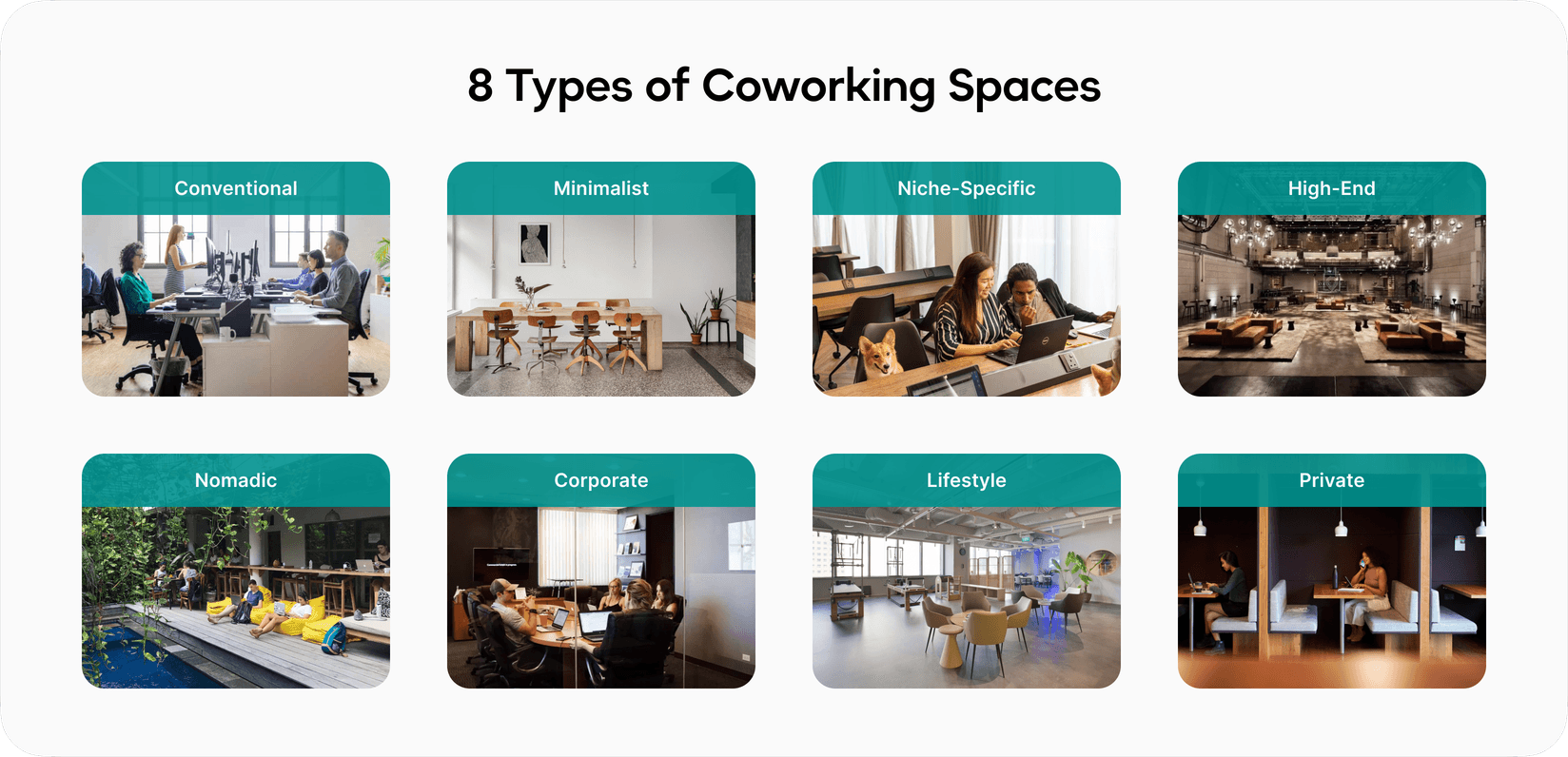- Features
- Solutions
- Pricing
- Resources
- Contact
- Book a demo

Are you dreaming of diving into the exciting world of coworking? That's awesome! But hold on a second because before you start picking out trendy furniture or brainstorming community events, there are some big decisions to make. We're talking about the kind of space you want to create – is it going to be classic coworking, a flexible office hub, maybe even a cool coliving setup, or something completely different? And don't forget, there's another factor to consider: should it be a cozy little nook or a sprawling coworking empire?
These questions might seem like a maze, but they're the keys to unlocking your future space's success. This article is your friendly guide to help you navigate these choices and make the informed decisions that will set you up for coworking greatness.
So, grab a coffee, get comfy, and let's unravel the myths and realities of coworking diversity together!
Defining Your Coworking Space
Coworking spaces are dynamic hubs of shared workspaces, fostering collaboration and nurturing vibrant communities. To help you navigate the diverse world of coworking, let's delve deeper into various types.

1. Luxury Coworking Spaces
- Picture upscale, downtown elegance with professionally designed interiors akin to five-star hotels.
- Membership fees tend to be on the higher side, attracting established professionals and corporations.
- Notable examples include Workville in New York City and the Continent Hotel in Bangkok.
2. Conventional Coworking Spaces
- These are the bread-and-butter coworking hubs catering to freelancers, startups, and remote workers.
- Rooted in a sense of community, they epitomize the essence of coworking.
- Notable examples include The Farm SoHo in NYC and Ministry of New in Bombay.
3. Coworking Spaces for Digital Nomads
- Tailored for adventurous souls who blend work with travel.
- Often located in scenic or remote destinations, they offer more than just a workspace.
- Notable examples include X-Cultural Acceleration in Bali and Kantoor Karavaan in the Netherlands.
4. Condominium Coworking Communities
- An intriguing blend of private office spaces within a shared environment.
- Ideal for individuals seeking both solitude and a sense of community.
- Notable examples include Treehouse in Los Angeles.
5. Corporate Coworking Spaces
- Crafted to impress and meet the needs of corporate clients.
- Professional, well-equipped, and often featuring ergonomic furniture and meeting facilities.
- A shining example is Bosch's Stuttgart Connectory.
6. Niche-specific Coworking Spaces
- Tailored to specific groups, such as women, families, or culinary enthusiasts.
- Often offering mentorship and unique amenities catering to the niche.
- Notable examples include The Wing, a women-only coworking network.
7. Minimal Coworking Spaces
- Ideal for freelancers seeking the basics: a desk, Wi-Fi, and a community-oriented atmosphere.
- The strength of the community may vary based on management and member interactions.
- An example is Punspace in Thailand.
8. Enterprises Offering Workspace as a Service
- A behind-the-scenes approach where major brands outsource coworking solutions.
- Often encompassing various coworking types to cater to diverse needs.
- Think of WeWork's strategic partnerships as an illustration.
9. Coworking Hotels
- Perfect for business travelers looking to combine work and accommodation.
- These spaces seamlessly integrate hotel amenities with coworking facilities.
- An example is Nest in Dubai.
10. Restaurant/Coffee Shop + Coworking
- Some eateries transform into coworking spaces during the day, providing convenience.
- Suitable for quick tasks but may lack an extensive sense of community.
- Ideal for casual meetings and remote work.
- Example: Verve Coffee Roasters in Los Angeles.
11. In-store Coworking
- Businesses repurpose unused office space within their establishments into coworking areas.
- A prime example is Staples Studio.
12. Coworking with Storage Facilities
- Tailored for businesses dealing with physical goods, offering both workspace and logistics solutions.
- An example is Big Fab Lab, a new kind of workspace loaded with remote office spaces and makerspace storage options.
13. Virtual/Hybrid Coworking Spaces
- Primarily exist in the digital realm but may have physical locations for occasional use.
- Ideal for remote workers, digital nomads, and home office users.
- CoFocus is an example of a virtual coworking space that allows one to connect with other users in a secure, private space for a joint work session.
14. Wellness Coworking Spaces
- Prioritize a healthy work environment featuring ample natural light, fresh air, and wellness amenities.
- Club W, a community wellness space combining three unique concepts: Wellness Lounge, Wellness Collective & Wellness Coworking, is a noteworthy example.
15. Coliving + Coworking
- Blend shared living and working spaces, catering to those who work while traveling.
- OUTSITE, a network of coliving spaces, embodies this concept.
Identifying Your Coworking Space Type
Consider your target audience, location, and the atmosphere you aim to cultivate. In the vibrant coworking ecosystem, there's no one-size-fits-all – it's about discovering your unique niche and vision.
Small vs. Big Coworking Spaces
Size is a pivotal factor in shaping your coworking business, so let's dive into the distinctions.

Defining Small and Big Coworking Spaces
Small Coworking Spaces
- These are the intimate, boutique-like havens of coworking.
- Imagine cozy settings with a personalized touch, akin to your cherished local café.
Big Coworking Spaces
- These are the corporate giants of coworking, often with multiple locations.
- Visualize expansive, bustling environments that can resemble coworking metropolises.
Pros and Cons of Small Coworking Spaces
Intimacy and Community
- Pros: Personal connections thrive, fostering a close-knit community.
- Cons: Networking opportunities may be more limited compared to larger spaces.
Flexibility and Customization
- Pros: You can adapt and tailor the space to cater to your community's unique needs.
- Cons: Limited resources may restrict your customization options.
Challenges of Limited Resources
- Pros: Smaller spaces typically entail lower overhead costs.
- Cons: You may have fewer amenities and services to offer.
Pros and Cons of Big Coworking Spaces
Scale and Amenities
- Pros: Abundant amenities such as gyms, upscale coffee bars, and event spaces.
- Cons: The sheer size can occasionally feel overwhelming, resembling a corporate office.
Corporate Partnerships and Stability
- Pros: Larger players often boast stable financial backing and valuable partnerships.
- Cons: The personal touch found in smaller spaces might be lacking.
Potential for Reduced Community Intimacy
- Pros: More individuals mean more potential connections.
- Cons: It's easier to feel lost in the crowd, potentially missing out on close-knit relationships.
Key Considerations in Choosing Size
Location and Target Market
- Consider your location and the audience you aim to attract.
- Small spaces might thrive in artistic neighborhoods, while larger ones suit bustling business districts.
Budget and Investment
- Be realistic about your financial resources.
- Smaller spaces are gentler on the wallet, whereas larger spaces demand greater upfront investment.
Growth Plans and Scalability
- Look to the future – do you envision expansion?
- Big spaces offer scalability, but smaller ones can also evolve over time.
In conclusion, the choice between small and big coworking spaces is significant. However, what truly matters is finding the right fit for your vision and community. Size is a factor, but the harmony between your space and your purpose ultimately defines your success.
Making the Decision
As you embark on this journey, it's time to make informed choices for your coworking venture. Here's the breakdown:
Evaluating Your Goals and Vision
- First and foremost, define your dream for your coworking space.
- Consider your goals – do you envision a creative haven, a tech hub, or something entirely unique?
- Your vision serves as your guiding star, so keep it front and center as you chart your course.
Market Research and Competitive Analysis
- Dive into research mode!
- Examine local competitors – what are their strengths and weaknesses?
- Understand your target market – who are your potential members, and what are their needs and preferences?
Financial Planning and Budget Considerations
- Time to talk finances! Budgeting is your trusty companion, especially if you're just starting your business.
- Be pragmatic about your financial situation – what can you realistically invest, and what will be your ongoing expenses?
- Factor in unforeseen costs – they have a knack for showing up unannounced!
Balancing Size and Diversity
- While size is important, diversity matters just as much.
- Strive to strike a balance that harmonizes with your vision.
- Consider how the size of your space can nurture a diverse and inclusive community.
Remember, this journey is uniquely yours, and there's no one-size-fits-all solution. Trust your instincts, conduct thorough research, and stay committed to your vision. Your coworking space is a canvas waiting for you to paint your dream upon it.
Conclusion
Congratulations! You've just embarked on an exciting journey to create your very own coworking space.
Throughout this guide, we've explored the ins and outs of the coworking world, from defining your space to embracing diversity and making crucial decisions. Now, it's time to put your plans into action.
But before you dive in headfirst, we've got one last piece of advice – check out our comprehensive guide on "How to Start a Coworking Space." It's your roadmap to success, filled with valuable insights, practical tips, and real-world examples to help you every step of the way.
So, whether you're aiming to build a cozy boutique space, a bustling corporate hub, or something in between, our guide has got you covered.
Don't wait any longer – your dream coworking space is just a click away. Get started today and turn your vision into a thriving community!




